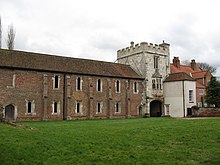Cawood Castle
Cawood Castle is a castle in the village of Cawood in the English administrative unit North Yorkshire . The 15th century buildings still preserved today were once part of a medieval palace owned by the Archbishops of York and demolished after the English Civil War . Today English Heritage has listed it as a Grade I Historic Building.
history
The Anglo-Saxon king Æthelstan probably had the first fortress built in Cawood on the site of today's castle. In the 12th century Cawood became the archbishop's residence. A castle was first mentioned in a document in 1181. Between 1374 and 1388 it was converted into a square castle. Many kings visited the castle, e.g. B. Johann Ohneland , who hunted in nearby Bishop's Wood in the 13th century . Documents show that the palace was often rebuilt and expanded. For example, Archbishop John Kemp had a gatehouse added. It was built from stones from the Huddlestone quarry near Tadcaster , which was also used for the building blocks for York Minster .
George Neville became Archbishop of York in 1465 and held a festival at the castle. The Earl of Warwick , the archbishop's brother, helped prepare the festival and is said to have made this festival bigger than the king's coronation celebrations. Guests were e.g. B. the Duke of Gloucester , the brother of King Edward IV. The festival lasted for several days and because of its size was known as "the great festival of Cawood". Records show that large amounts of food and drinks were consumed there, e.g. B. 104 oxen , 6 wild bulls , 400 swans , 1000 capons , 104 peacocks and 25,000 gallons of wine.
The palace was the main residence of Thomas Savage during his tenure as Archbishop of York and he died at Cawood Castle in September 1507. Cardinal Wolsey came to Cawood Castle as Archbishop of York in 1530 and made himself popular with the residents of the village by serving the aftermath corrected many years of neglect. But even before he was enthroned as Archbishop, the Earl of Northumberland had him arrested on charges of high treason ; Wolsey fell ill in Leicester on the way to London and died. Thus Mother Shipton's prophecy was fulfilled that he would see the towers of York Minster but would never be enthroned there.
In 1642 the English Civil War began and the palace was initially held by the royalists . It was then taken by the Parliamentarists , but the Earl of Newcastle was able to recapture it briefly for the Royalists in 1644. Shortly afterwards, however, Lord Fairfax recaptured it for the parliamentarians and it served as a prisoner of war camp . After the civil war, the palace was no longer used and was demolished, only a few farmhouses and parts of the wall remained. The basement was filled with rubble and earth.
today
The only remaining parts of the palace are the gatehouse and the banquet hall. Bricks from the destroyed palace were used to build the surrounding houses. The foundations of some other buildings have been preserved, as have the palace's basements, which were excavated in the 19th century.
The gatehouse served as a courthouse until the 1930s, then as an officers' mess and building for the British Home Guard during World War II .
The castle is now owned by the Landmark Trust , who renovated the gatehouse as a vacation home, while the two-story banquet hall remained in good condition and weatherproofed but uninhabitable. Remains of other buildings can be seen outside the banquet hall - there were more modern farms and a wall along the road that were removed when the Landmark Trust took over the castle and had it restored.
The Schlossgeviert was bought by the municipality in the 1980s in order to keep it as an open space in the middle of the village. In the square there is a population of crested newts : in the middle is a pond that was created in the 19th century for ice skating. There are also remains of medieval fish ponds. The site was expanded with financial aid from the Local Heritage Initiative , a small fund launched in 2000 to help communities bring their local history to life.
Individual evidence
- ^ SJ Gunn: Savage, Thomas (d. 1507) in Oxford Dictionary of National Biography . Oxford University Press, Oxford 2004. Retrieved February 15, 2016.
- ^ Cawood Castle Garth Group . Tiscali. Retrieved February 16, 2016.
- ↑ Website of the Local Heritage Initiative (English) ( Memento of the original from May 23, 2006 in the Internet Archive ) Info: The archive link was automatically inserted and not yet checked. Please check the original and archive link according to the instructions and then remove this notice.
Web links
- Landmark Trust website
- Pamela Y. Ross: Cawood Castle . BTInternet. ( Memento from September 29, 2007 in the Internet Archive )
- Cawood Castle . Gatehouse Gazetteer.
- Cawood History . McEntire.
Coordinates: 53 ° 49 '53.4 " N , 1 ° 7' 51.2" W.
